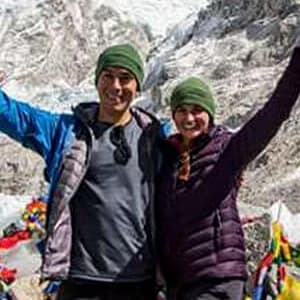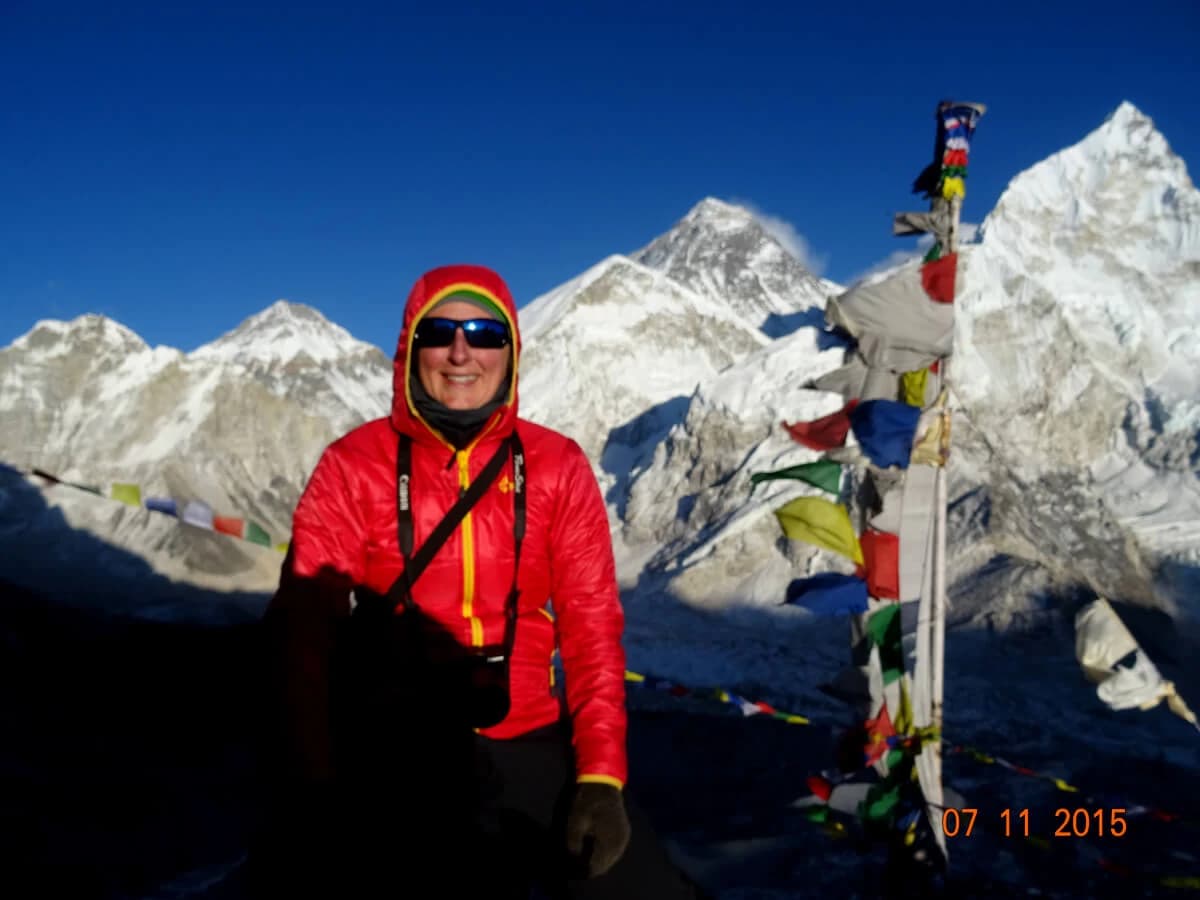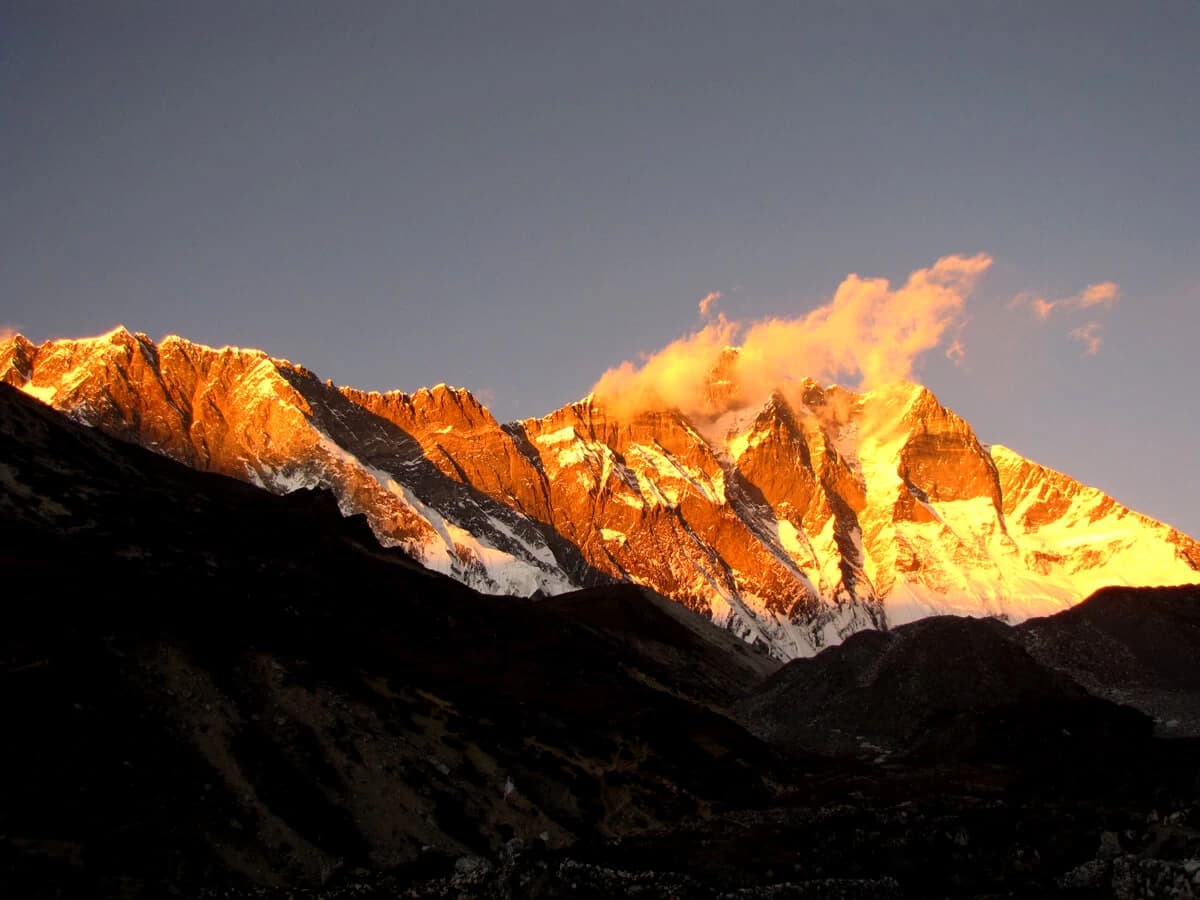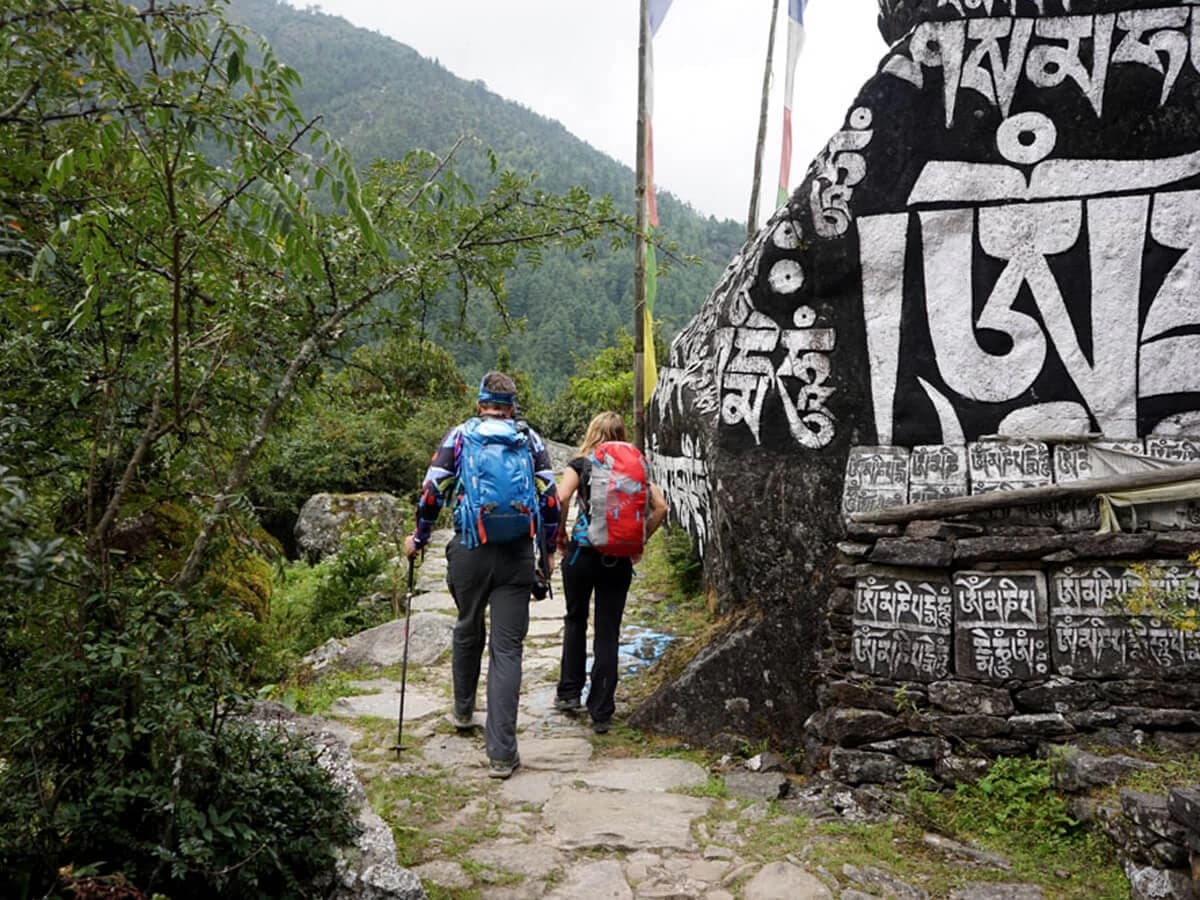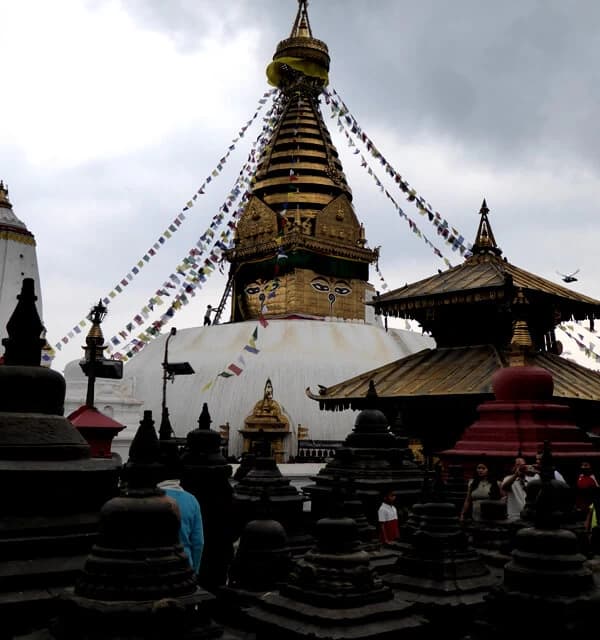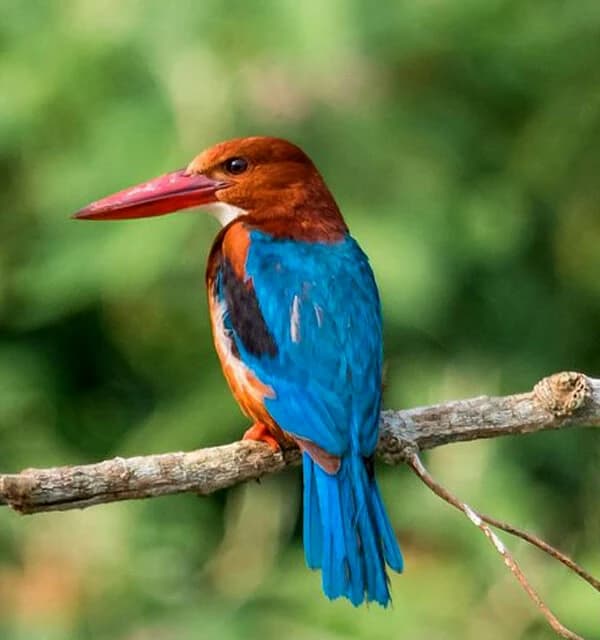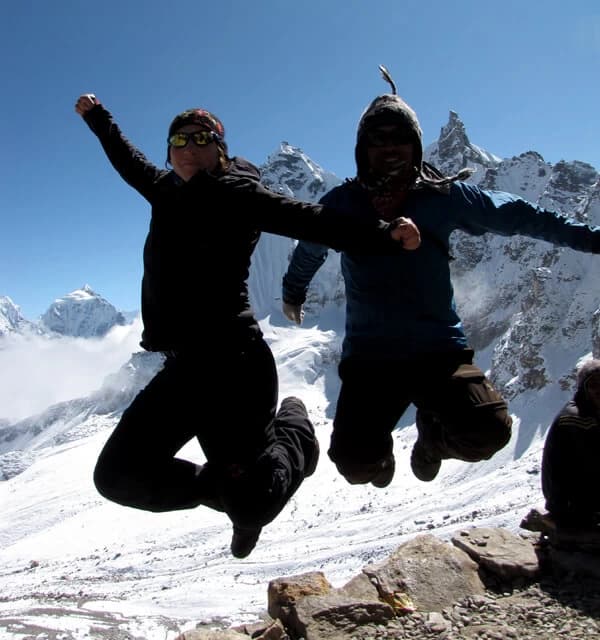A journey to the base of Mount Everest (8848m), locally known as Chomolungma (Mother Goddess of the World) by Sherpas and Tibetans. A mountain that is not just a mountain but is considered a living deity. Trek passing through the bustling street of Namche and the world-renowned monasteries. A trail not only filled with scenic views but also myths, legends, stories, and beliefs.
Everest Base Camp Trek - 12 Days
Overview
The Everest Base Camp Trek is a renowned journey to the base of the world’s highest mountain, Mount Everest (8848.86M). Located in the Khumbu Region of Nepal, the trek follows the footsteps of Sir Edmund Hillary and Tenzing Norgay’s historic 1953 climb. The southern base camp in Nepal became historically significant in 1953, when Sir Edmund Hillary and Tenzing Norgay began their successful ascent of Everest from this route. This trek combines breathtaking Himalayan views with rich Sherpa culture, as travelers walk through charming villages, monasteries, and the vibrant town of Namche Bazar with scenic trails, all while standing at the foot of Everest. Everest Base Camp is not only a key site for mountaineering expeditions but also a major attraction for trekking destinations, attracting thousands of adventurers each year.
Everest Base Camp – Must do!
Everest Base Camp Trek is not just a trek, but The Trek. EBC isn’t a trek you consider, but it’s the trek you do, at least once in a lifetime, because it’s not just any other regular trail, but the journey that defines the Himalayan adventure. The hype of Everest isn’t something entirely based on advertisement by Governments nor the locals of Khumbu, but the trekkers themselves. Some may question the quality of the trek in comparison to other renowned trails, but those who have done this trek know why, every year, Everest has thousands of visitors, and some even risk everything they had, have and could get just to reach the top of Everest. The Everest Base Camp trek is a combination of the rich Sherpa culture, scenic views of multiple peaks, villages, history, and everything a journey can give you. EBC didn’t become the world's most iconic trail solely based on Mt.Everest, but also on the surrounding scenery.
The Everest Trek is more than just a route to Base Camp; it’s a journey through the entire Khumbu Region, one of the most stunning landscapes on Earth. The main route of the EBC starts from Lukla and passes through the bustling streets of Namche Bazar to the peaceful monasteries of Dingboche and Tengboche. The trails stretch beyond Everest Base Camp to the turquoise lakes of Gokyo, high passes of Cho la and Renjo la, panoramic viewpoints like Kalapatthar, and other peaks. In summary, Everest Trek is about the whole Khumbu region as much as it is about the views of the Himalayas. There are indeed no other treks that can give as much thrill as EBC can, solely on the view from Kalapatthar. And when one walks through the streets of Namche Bazar, brimming with Sherpa culture and their history, a hub for both trekkers, expedition teams, and the native of Namche, along with century-old monasteries of Tengboche and Pangboche, the way of living of the indigenous people of the Khumbu region is an experience that can’t be missed.
Everest Base Camp – The trek for all
The 12 Days Everest Base Camp Trek is more than just a trail to base camp; it’s an experience that speaks to all kinds of travelers. For those chasing adventure, it unfolds with a panoramic view of Everest along with other major peaks like Ama Dablam, Lhotse, Mera Peak, and countless other peaks in the Khumbu Region. For culturally curious and spiritual seekers, it offers a glimpse into the Sherpa way of living, from stone houses to the bustling market of Namche. The Everest region not only houses countless peaks but also century-old stories and knowledge. The trail passes through centuries-old monasteries of Tengboche and Pangboche, which still to this day preserve their teachings and ancestry. To summarize, Everest Base Camp is home to every traveler with different motives and goals, those who seek spiritual enlightenment, those who are chasing adventure, and those who want to indulge themselves in Himalayan culture, and are welcomed with fluttering prayer flags and mani walls along the trail.
Everest Base Camp – Perfect Trek Time
Trekking season in Nepal is currently divided into two parts, and both focus on getting the maximum quality trek experience. When planning a trip to Everest Base Camp, what you want to get out of the trek should be considered. Both seasons are favorable for trekking, though offering slightly different experiences. The two trekking seasons of Nepal refer to the time or month from March to May and September to early December. Confusion may arise when preparing plans for the trip as to when to trek, so here are some key highlights on what you may experience in different seasons: -
Spring season (Mar-May) – Pre-monsoon
- Warm days and less rainfall make trekking pleasant.
- Trails are colorful with vibrant Rhododendron Forests.
- Less haze makes the Himalayan peaks visible.
- Festival like Holi falls around the same time.
- Possibility of Saga Dawa from May to June in monasteries.
- Active Himalayan wildlife makes it easy to spot during the trek.
Autumn season (September-November) – Post-monsoon
- Crystal clear skies after rain make the peaks exceptionally photogenic.
- Dry season with minimal rain, ideal for long treks.
- Warm days and cold nights.
- Major festival of Nepal: Dashain and Tihar falls around the same time.
- Mani Rimdu festival in Tengboche during Oct-Nov.
- The possibility of locals celebrating the harvest season in villages.
These points highlight the major factors of what you may possibly experience during your trek, depending on the season you choose. But statistically, most of the trekkers choose during Sep-Nov as Nepal experiences the post-monsoon period after mid-September, making days warm and nights mostly cold in high altitudes, which makes an ideal time for adventure such as trekking. As major festivals such as Dashain and Tihar fall around the same time, it is a memorable experience of Nepal's culture as well.
Everest Base Camp – Difficulty
Everest Base Camp was a considerably difficult trek before Lukla Airport was built. Before 1964, the trek's starting point was Jiri or Salleri, which would take another 4-5 extra days. However, in 1964, under the guidance of Sir Edmund Hillary, Lukla Airport was built. Though it was mostly a small grassland on a hilltop, Lukla immediately became the starting and ending point of the Everest region. Trekking into the Khumbu region became much easier after the construction of Lukla airport, and it became easily accessible for every traveler.
A standard itinerary to Everest Base Camp takes at least 10 to 12 days up to days, considering the time to adapt to the altitude. With a max altitude reaching up to more than 5500 meters above sea level and the alpine terrain of the Himalayas, it can be said that this trek is not for complete beginners. A trek's difficulty can’t be determined completely based on how high it reaches, but on how difficult the terrain is, facilities at the lodges, and trails (uphill and downhill). From this point of view, it may sound exclusive for professional trekkers, but compared to other trekking routes, Everest is well developed and facilitates professional service, which makes the trek available to starters as well. If you are fit and able to walk with no hindrance, the Everest trek is your go-to option.
Accommodation and Food in the Everest Trek Tour
For a remote trek, with almost no modern transportation to provide daily needs, the Everest trek surprisingly facilitates excellent services. The trek goes on from lodge to lodge, and a few lodges along the way are also known for providing a luxury service in the Himalayas. Due to the craze of EBC globally, lodges in the Khumbu region use Mules and Yaks to transport goods and even porters to carry furniture and other materials that can’t be locally produced. Every lodge is built in a way to accommodate trekkers comfortably. Rooms may look basic, but are properly cared for and cleaned. Soft futons and blankets at night, a warm heater in the dining hall.
The food is really exceptional, with different varieties and restaurants, to local cafes in Namche. With the growing popularity of Everest, places like Namche are now more than just a rural village, but a fantasy town that provides every need of modern humans. Namche’s famous café, also known as Yak-buck coffee, a replica or copy of Starbucks, has also gained fame globally. The establishment of such cafes and restaurants, even though lodges already provide food and drinks, says a lot about the development of the trekking region.
Highlights of Everest Base Camp
The main spotlight of our 12-day Everest Base Camp trek would be Mt.Everest itself. A mountain that is majestic enough to reach heaven, known as the highest point on the earth. Everest was named after Sir George Everest, the surveyor general of India in 1865, because the British surveyors thought the local names weren’t widely known or consistent across Nepal and Tibet. Everest is locally known as Sagarmatha, meaning स्वर्गलाई छुने माथ जसको, which translates to Heaven reaching peak or head. The name was made official by the Nepalese government in the 1960s, but the localities of the Solukhumbu region knew it as Chomolungma (Tibetan Name), meaning mother goddess of the world, where chomo translates to goddess and lungma translates to mother. Locals didn’t treat Everest as just a mountain but as a sacred living deity that protects the land. Climbers are also seen practicing rituals or praying before an expedition to receive a blessing for a successful ascent. These stories of Everest also highlight the wonder of the trek and not only the physical peak. Since the trek is not only about reaching the base camp or viewpoint of Kalapatthar, but also about venturing deep into the Sherpa culture, stories, and folklores of monasteries. To put it simply, Everest is known for many wonders which can only be known when visited. Some other things that make EBC truly remarkable can be categorized into the following groups.
Cultural and spiritual significance: -
Before the trek hype and tourist centralization, the Khumbu region was primarily a settlement of Sherpas. The place is still full of natives carrying centuries-old traditions and beliefs, a testament to their rich civilization. With Tibetan Buddhism being the main religion, places like Tengboche, Dingboche, and Pangboche preserve their teaching to this day. Khumbu is not only known for mountains, but also for its deep cultural and spiritual traditions, which make the Everest region so unique. Some key highlights being: -
- Major monasteries of Tengboche, Pangboche, and Thame.
- Chortens and mani walls line the trails.
- Prayer flags on high passes, bridges, and homes.
- Festivals: Dumji, Mani Rimdu, Lhosar, and Saga Dawa.
- Yeti relics of Pangboche monastery.
- Serpent spirits of lakes and rivers
Wildlife in EBC
The EBC trail is not only about the mountains and monasteries, but also the changing vegetation of the Khumbu Region. From lush valleys to barren Himalayan landscapes, the flora and fauna create the unique natural richness of the Khumbu. The trek starts from the lower Khumbu at around 2300M to the upper Khumbu of 5500M, which gives a unique shift in vegetation. The Sgaramatha National Park houses more than 26 mammal species and 118+ bird species, which include mammals like Himalayan Tahr, Musk Deer, Himalayan Goral, Red Panda, Snow Leopard, and Yaks. Among them Himalayan Tahr and deer can be seen often in trails, and birds like the Danphe, Snow pigeon, and Bearded vulture.
Early morning drive to Manthali (132 km) that takes some 4 hours. Usually we leave at 3 AM. Upon arriving at Manthali Airport, we take an exciting and adventurous flight of 25 minutes to the mountain airfield at Lukla, the Tenzing Norgay, and Edmund Hillary Airport from Kathmandu, with beautiful views of the landscape and snow-capped mountains. We commence our Everest Base Camp Trek from Lukla and head to Ghat, where we stop for the night today. It is a pleasant walk of 3 hours today, passing many Tibetan Buddhist prayer walls, monasteries, and monuments. We have a tea or lunch trek on the way to Ghat.
After hot breakfast; we start our trek to Namche Bazaar via Toktok, Benkar, Monjo and Jorsalle. After a 3-hour hike, passing many suspension bridges with a good view of Mt. Thamserku, we should enter our Sagarmatha National Park entry permit and will have lunch in Jorsalle. Then we start to climb steeply up, slowly passing a high suspension bridge till Namche Bazaar, which takes about 2 and a half hours. Stay overnight in the lodge.
As it is very crucial for the trekkers to schedule an ‘acclimatization day’ to acclimatize our bodies and to avoid AMS further up the trail. This never means we have to stop walking, but it is always recommended to hike to higher elevation and sleep at lower elevation so we can hike up to the Everest View hotel for a panoramic and spectacular view of mountains, walk to Twin Sherpa village (Khumjung and Khunde), visit the Sherpa museum, or hang around at Namche Bazar. There are many hotels, lodges, restaurants, bars, cyber cafés, boutiques, souvenir shops and groceries at Namche. This place is nice to hang around. Stay over in the lodge.
In the morning, we start our trek like before, and the trail continues straight until reaching Kyanjuma and takes about a 1 and a half hour walk, and then the trail climbs down to the Dudh Kosi River and crosses by suspension bridge. We can see a series of picturesque water-driven prayer wheels. Then we will have lunch in Phungi Thangna. The steep ascent brings us to Tengboche village. Tengboche is a village in Khumjung in the Khumbu region of northeastern Nepal, located at 3,867 meters. In the village is an important Buddhist monastery, Tengboche Monastery, which is the largest gompa in the Khumbu region. Explore the region’s most active Buddhist monastery at 4PM and visit the sacred land exhibition center. The views of the mountains are fabulous in the morning and evening. Stay overnight in the teahouse.
The trail continues through the rhododendron, birch and blue pine forests until reaching the suspension bridge near the Pangboche village, which takes about 2 hours. Then we cross the bridge, and we climb up a gently steep trail until Pangboche village. We will have lunch break at Somare. After lunch, the trail continues in the isolated pastures and fields till Orsho; the left trail goes to Pheriche, and the right trail continues to Dingboche. Then we continue our trek, following the upstream of Imja Khola. Finally, we arrive in Dingboche, which takes about 2 hours. Now we have a good view of Amadablam, Island Peak, Lhotse, Tawache, Tsolache, Lobuche and other peaks. Stay overnight in the teahouse.
It is important to take another acclimatization day at Dingboche to make sure you are well-acclimatized; some people skip the rest and acclimatization day at Dingboche. You see how well you go on the trail head. But it is always wise to have a rest and re-energizing day at Dingboche at the altitude of 4,410 m/14,465ft. from the sea level. This place is warmer than Pheriche to the other side. If you feel stronger, you have a choice to make a day trip to Nangkar Tshang (5,616 m), which offers an amazing view of Mt. Makalu (8.485 m), the fifth highest mountain in the world.
The short climb brings us to the ridge above Dingboche and past the small Chhorten and descends to the broad terrace above the Khumbu Khola valley. The trail goes through the terrace until reaching Thukla. We can see a short glimpse of the majestic peaks of Pumori, Nuptse, Lobuche, Cholatse, Tawache, Amadablam and other small peaks. The trail steeply ascends from Thukla until reaching the top of the ridge. There are an array of cairn memorials and large heaps of stones with prayer flags, remembering mountaineers who passed away on missions to climb Everest. Then your trail continues to Lobuche village, which takes about an hour. There is wifi services Stay overnight in the lodge.
The most-awaited day is finally here. Today we trek to Everest Base Camp (5,364m), the closest you could ever be to Mt. Everest without being a climber. We continue our trek on the left bank of Khumbu glacier and steep climb up till Changri glacier, and then short descend to reach Gorak shep. It takes about 2 and a half hours. We take a lunch break there, book room and drop off our stuff, then hike to Everest Base Camp (5,364m) for the excursion. Many hike up to Kalapattar to catch the stunning sunset view on Mt Everest instead of hiking to base camp on the same day, and they do an EBC excursion the next day, then trek back to Pheriche.
Early in the morning, we hike to the famous Kala Patthar viewpoint, which is 5,550m high. It is a 400-meter climb up to the Kala Patthar view point from Gorakshep and takes max. 2 hours. Now the view is 360˙degree of Mt. Everest, Nuptse, Lhotse, Khumbutse, Pumori, Lingtren, Amadablam, Thamserku, Lobuche peak and other peaks all around. There is also an unobstructed view of sunrise and sunset. Then we walk down to the hotel. After breakfast in Gorakshep teahouse, continue our trek to Pheriche via Lobuche and Thukla; the trail continues gently descends till reaching Pheriche.
This day after breakfast, we return back through Panboche and walk through many Buddhist monuments with brilliant mountain View. After lunch at Tengboche Then, the trail becomes a steep descent through the forest to Phungi Tenga and cross the bridge over Dudh Kosi River. After crossing the bridge, we keep ascending through a forest and arrive to Kyangjuma. Now we walk the level trail the mountain flank until reaching the large settlement of Namche Bazar. Stay overnight in lodge.. It takes 7-8 hours walk today. Stay overnight in lodge.
After breakfast, we trek down toward the Suspension Bridge over Dudh Koshi (Milk River) and then pass through several beautiful villages. Our arrival in Lukla brings an evening in our last Tea House and, usually, a party with your trekking crew: you made it! Thanks to great teamwork and perseverance, you’ve accomplished a physical feat of which others only dream. This is your last night on the mountain, which can be bittersweet.
We take a morning flight back to Manthali, then drive (130KM) to Kathmandu if everything goes well according to the schedule, reflecting a life-changing journey to the Everest Base Camp.
Upon arriving in your hotel, you have a choice of what you want to do. Go shopping or rest and relax in the hotel. In this way, our journey of the Everest Base Camp trek will be concluded!
Lukla Flight Update: This alters when going to the Everest Treks
Because of high air traffic congestion in Kathmandu’s only airport that is for both international and domestic flights. CAAN (Civil Aviation Authority of Nepal) decided to continue the Lukla flight from Manthali in the Ramechhap district during the peak trekking season. This flight diverts has significantly altered the logistics for the Everest treks. To accommodate this change, we will have to adjust your departure schedule on the first day of your journey, our guide will pick you up from your accommodation around 1:00 to 2:00 AM and drive to Manthali (132 KM / 3 to 4 hours drive) to catch morning scenic flight to Lukla
A good option! Going to Manthali a day before your flight to Lukla for comfortable travel rather than rushing up. This just requires an extra day. Speak/write to your trip planner while booking.
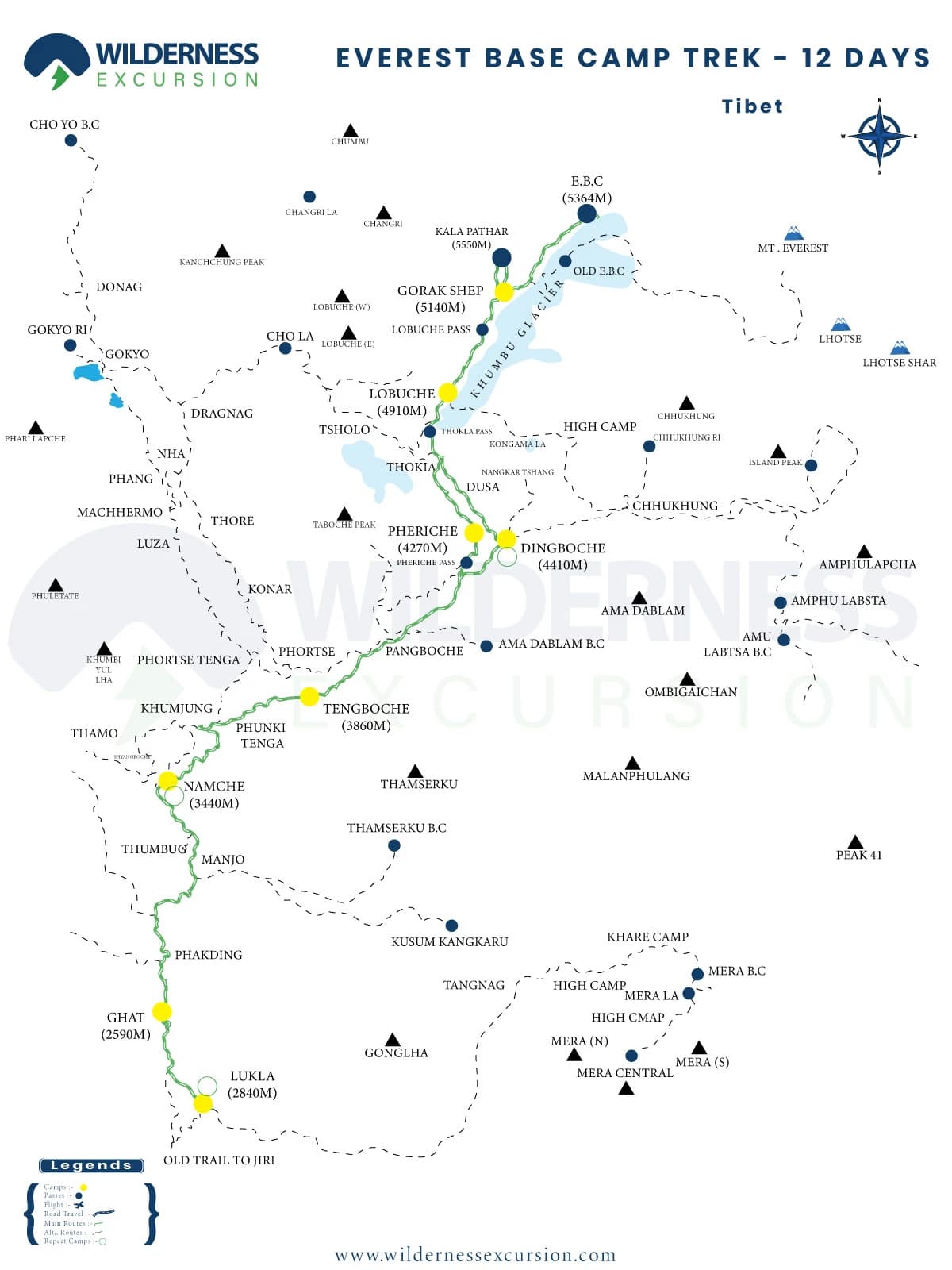
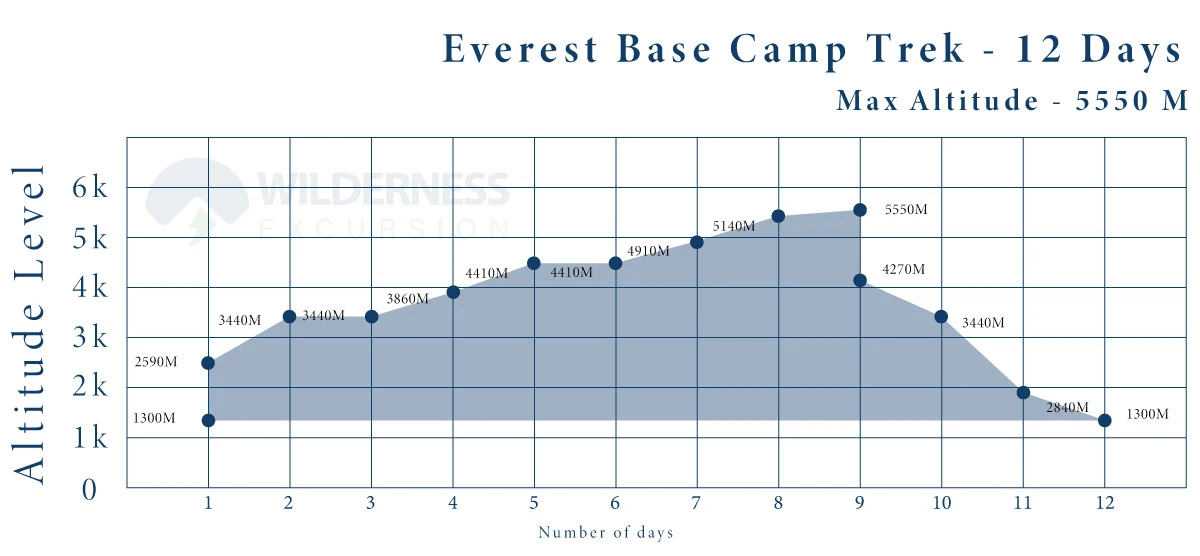
- An experienced, certified private Everest Base Camp Trek guide for 12 days.
- 1 Sharing a high-altitude porter for 2 travelers (weight limit max. 25 kg plus their stuff).
- Meals: 11 breakfasts, 11 lunches, and 11 dinners during the trek.
- Lodge accommodation during the trek on a twin or triple-sharing basis.
- Lukla round-flight fare (cost: USD 432.00) per person, and airport taxes.
- Flight fare of your guide and airport taxes.
- All necessary Everest Base Camp Trekking permits.
- Office service charges and government taxes and VAT, etc
- Guide and porter fees with all their expenses.
- Accommodation, meals, and a guided tour in Kathmandu.
- Bar drinks and bottled beverages such as Coke, Fanta, beer, etc.
- Hot shower, hot water, wifi, and battery charge during trekking.
- Personal travel insurance, internet, phone calls, laundry,
- Emergency evacuation (will be done in your account).
- Tipping your guide and porter.
Embark on your dream trek of legendary Everest Base Camp with the expert team from Wilderness Excursion. Our 14 years of excellence in operating Everest treks in Nepal. As innovators in adventure trip services, we are pleased to offer you exclusive add-ons (extra services with additional costs) to make the modern Everest Base Camp Trek booking easier to enhance the adventure trekking, and be budget-friendly.
- Kathmandu to Lukla Helicopter Flight Cost USD 550: Begin your trek in comfort with a shared scenic helicopter ride from Kathmandu to Lukla. Skip the waiting time and enjoy breathtaking bird’s-eye views of the majestic Himalayas as you head straight into the heart of the mountains additional cost per person of USD 550 for a shared helicopter.
- Lukla to Kathmandu Shared Helicopter Ride Cost USD 550: Conclude your adventure with a hassle-free shared helicopter flight back to Kathmandu. Sit back, relax, and soak in the stunning aerial panorama of the Himalayas—an unforgettable way to end your journey. Extra cost USD 550 per person on a five-person shared basis.
- Gorakshep to Lukla by Helicopter Cost USD 500: If you consider returning by helicopter to Lukla after the Everest Base Camp, it will cost USD 500 per person from Gorakshep to Lukla (4 people shared basis). Private charter will cost USD 2000
- Gorakshep to Kathmandu by Helicopter Charter Cost USD 950: You can add a helicopter flight from Gorakshep to Kathmandu during the reservation process. For a spectacular conclusion to your trek
With these thoughtfully listed add-ons for your Everest Base Camp Trek - 12 Days transcends a typical adventure, transforming into an amazing experience you will treasure for a lifetime. Book your adventure trip today and transform your every moment magically into a fabulous travel story.
Some tips to tailor your 12-day Everest Base Camp Trek with extra service
- Pick up your preferred date to start the trek.
- Enter the number of participants in the Everest Base Camp Trek.
- Select the add-ons for the listed items if you need any
- Click on “Book this trip”
- Complete the advance deposit payment.
Check our published date for the fixed Departure of the Everest Base Camp Trek! If it doesn’t match, we are happy to customize your Everest Trek perfectly to suit your interests and needs, creating a unique trekking itinerary for you at Wilderness Exursion.
Permits and Entry
To enter the premises of Everest, trekkers require the Sagarmatha National Park entrance fee of 30 USD and the Pasang Lhamu Rural Municipality entrance ticket of 20 USD per person.
Note: Lukla flights are often diverted from Manthali Airport during peak season to decrease the air traffic at TIA. This diversion causes the itinerary to change a bit, making trekkers depart in the early morning, 2-3 AM, to catch an early flight to Lukla. We suggest trekkers take an extra day for an overnight in Manthali.
Packing list and Preparation tips
Packing can be quite tricky when trekking in the routes of Everest; most of the places are well developed and provide every daily need. But, there are still some packing and preparation tips that can be used for comfortable and safe travel: -
- Carry some cash change, as some lodges may not facilitate online transactions.
- Pack basic medicines and personal safety care.
- It's better to buy sanitary needs before the trek.
- Minimum 2L water bottle and water purifier (if needed).
- Pack energy bars and snacks.
- Optional board games for entertainment.
- Waterproof essentials like rain covers and raincoats.
- Layer of clothes in the daytime.
- Down jackets for the night and a sleeping bag (if needed).
- Power banks or portable solar backup
- Headlights and pocket knives.
- Sunglasses, buffs, and a pair of gloves.
These are some of the tips that might be useful, and you can also apply your own methods of packing if you are a professional and have done trekking in the past and have basic ideas of what you may need when trekking in places like Everest. If you have any further queries regarding the trek or on how and what to do, please feel free to contact us.
Travel Safety Information.
Nepal is a safe country for tourists to travel alone as well, but there can be some uncertainty from other parties and their own miscalculations. When it comes to safety, it’s not always robbery and others, but also people's beliefs. Since Nepal is a diverse country with people of different castes, cultures, religions, and traditional beliefs coexisting together, some things can be done and can’t be done when being at a particular place. For such cases, there are a few precautions you can take: -
- Keep your personal documents safe and separate.
- Carry pepper spray or a small pocket knife for emergency purposes.
- Save countries' emergency contacts for unexpected situations.
- When in rituals, ask if it’s possible to take photos or videos; some people may find it offensive or may not allow capturing images.
- Many monasteries have rules about not taking any kinds of photos or videos inside the premises; if no signboard is seen, ask the locals first.
(These points can be useful for both solo trekkers and those who travel through agencies. If you have a guide hired, always ask about things you are unsure of.)
Things to do after the trek!
If you are having a dilemma about what to do after the trek, there are a few things you can do: -
- Extend your trek days and visit the nearby monasteries of Khumbu.
- If you are in Kathmandu, there are lots of options for short hikes near Kathmandu.
- Or extend your visa days and visit the old cities of Kathmandu, i.e., Bhaktapur, Patan, and Kathmandu Durbar Square.
(If you are interested in a round trek of Everest, feel free to check our Everest Three Passes Trek.)
Myths and stories of Khumbu
In the Khumbu region, the mountains are more than peaks of rock and ice; they are sacred homes to gods, spirits, and mysteries that have shaped Sherpa life for centuries. Everest, or Chomolungma, is believed to be home to Miyolangsangma, the goddess of inexhaustible giving. Before every expedition. Monks perform ceremonies to ask for her favor, reminding mountaineers that climbing is as much a spiritual journey as it is a physical one. Nearby, the sacred peak of Khumbila, also known as Khumbu Yul Lha, is believed to be the home of the guardian of the valley, who watches over villages, animals, and travelers alike. It is considered too sacred to be climbed, remaining untouched to this day. Even the lakes and high passes of the Khumbu region are believed to be inhabited by serpent spirits and other mysterious snow beings, such as Yeti—the mysterious snow being whose relics once rested in Pangboche Monastery and whose footprints startled explorers like Eric Shipton in 1951. For the Sherpa, Yeti is neither a monster nor a myth alone but a guardian spirit of the high passes, appearing as an omen or protector. Together, these deities and legends give the Everest region a living soul.
As Mount Everest, the highest peak in the world is co-owned by Nepal and Tibet (China), there are actually two Base Camps located at the opposite sides of the peak respectively. The Everest Base Camp in Nepal side, also called South Base Camp, is in the south side of the Mt. Everest. At an altitude of 5,364m, it is within the Sagarmatha National Park of Nepal.
The quickest way is to fly from Kathmandu to Lukla airport, high in the Himalayas. From here, it's a couple of days' walk to Namche Bazaar, the Sherpa capital of the Everest area. You'll need at least a couple of days here to acclimatise to the altitude, and then about five to seven days to walk to the Base Camp. You can stay in lodges, or you can camp if you're part of an organized tour.
Alternatively; you can start the trek from Jiri (See classic Jiri Everest Base Camp Trek) or take a flight or jeep to Salleri from Kathmandu hence you commence the trek much lower down that makes you fitter and better acclimatized.
Usually Everest Base Camp requires 12 to 14 days, and costs range from about USD 1200 to 1600 per person based on minimum two people group size basis. It is cheaper when the group is bigger. That cost includes your internal airfare, trek permits, guide, porter, meals and accommodation as well. The cost depends on group size and mode of tour.
The answer is actually "no.” You can't see Mount Everest from Base Camp; there are other insanely tall peaks blocking the view. You need to hike to Kalapatthar at an elevation of 5545 meters to see the see the stunning of Mount Everest. You'll have great views of the world's tallest mountain, so you'll have lots of snaps of Mount Everest from there. Gokyo Ri is the best view point of Everest if you are trekking to Gokyo Valley.
Yes, you can get a tourist visa on arrival at Tribhuvan International Airport (TIA) in Kathmandu, Nepal. Most foreign nationals can get a visa upon arrival, but some nationalities are not eligible and must apply in advance. To get the visa at the airport, you can fill out the online visa form, pay the fee, and then present your passport and documents to the immigration desk. Browse through the link for more details.
Kalapatthr view point that lies at the elevation (5545 meter | 18187 ft.) is the highest pint we will reach in EBC Trek in entire route. This is a must do side trip in Everest Base Camp trek.
No worries, the Everest Base Camp (EBC) trek is very feasible for vegetarians, as vegetarian options are widely available and common on the trail due to the local culture. You can expect to find vegetarian staples like dal bhat (lentil and rice dish), noodles, and potato dishes, as well as western options like pizza and pasta, though you should avoid meat and be mindful of hidden dairy in some vegan meals.
Tipping is common in the hospitality industry in Nepal. Usually, the crew directly involved in your service is rewarded at the end of the trek. Though tipping depends on your perception. How much is the tipping amount? Follow the link. https://wildernessexcursion.com/tipping-guides-and-porters-in-nepal
A wonderful experience with Wilderness Excursion to Everest Base Camp.
It has been an unforgettable trekking of 10 days in Khumbu Valley. Everything was very well organized by Pradip and his team. Many thanks to Guide Aital that was able...
Simply the best! Thank you, Wilderness Excursion! And big thank you, Pradip! I did EBC and Kala Patthar with Wilderness Excursion in March 2018! Everything was perfect! Highly recommend these guys! Thanks, Pradip and Lhakpa Sherpa! All the best
Janos!
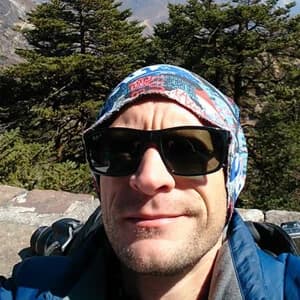
My husband and I booked our Everest Base Camp trek through Wilderness Excursion, working with Pradip. The process was seamless, and we felt well-prepared heading into our trek. We had the most wonderful experience with our knowledgeable guide and helpful,...
